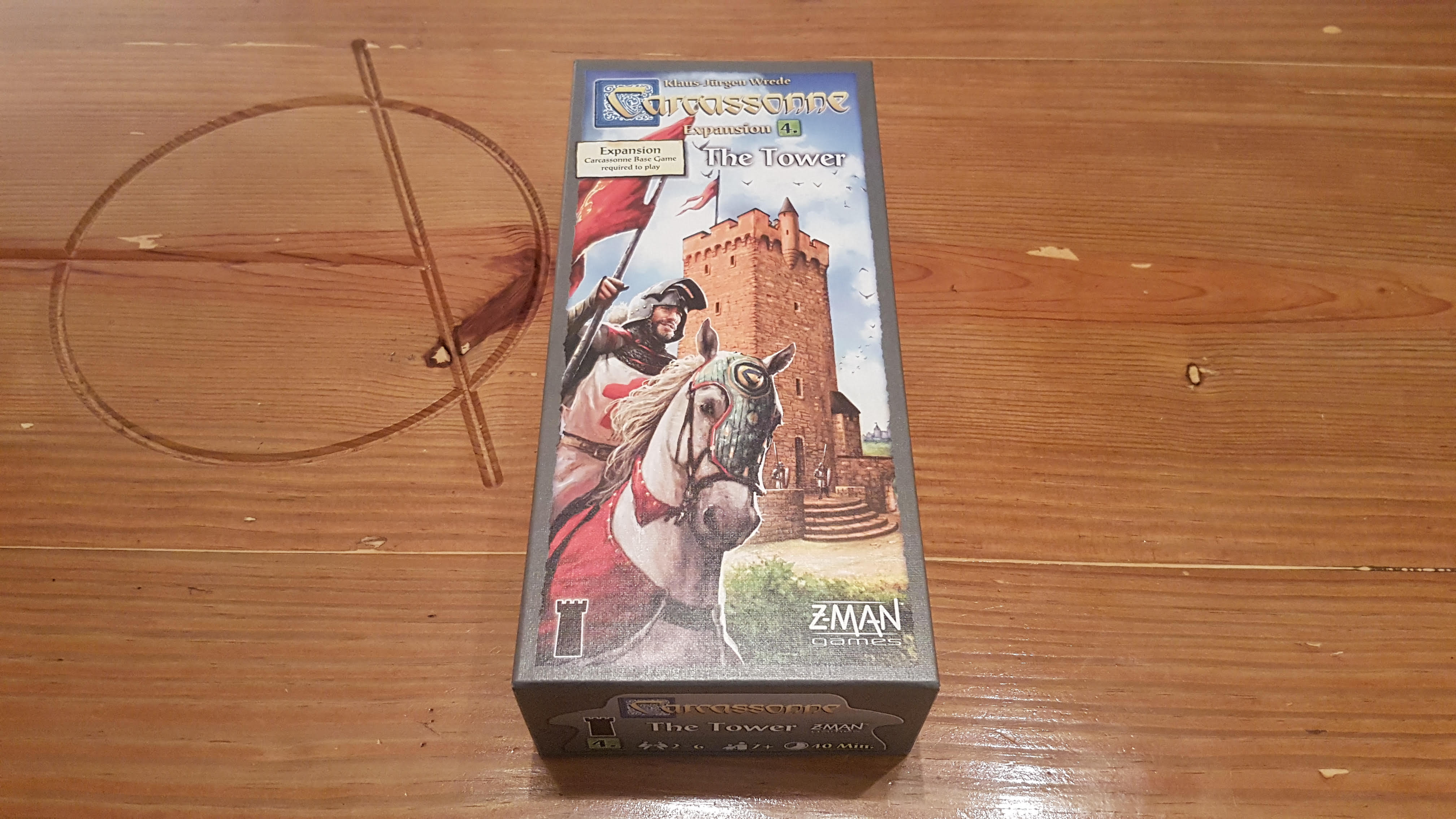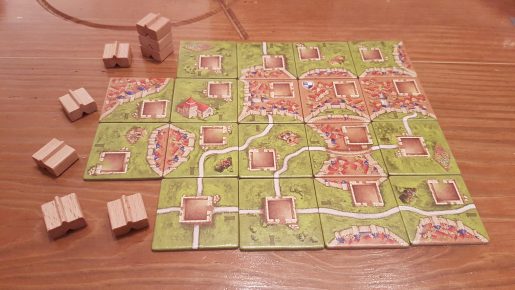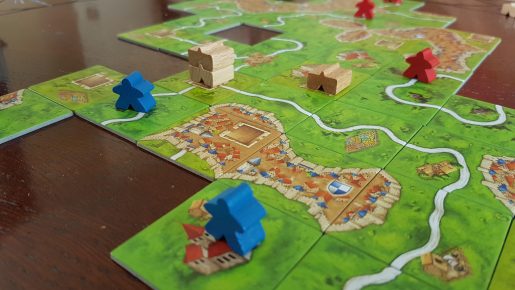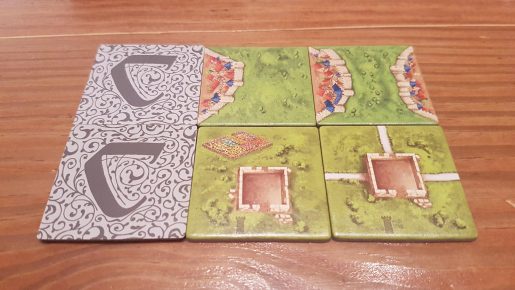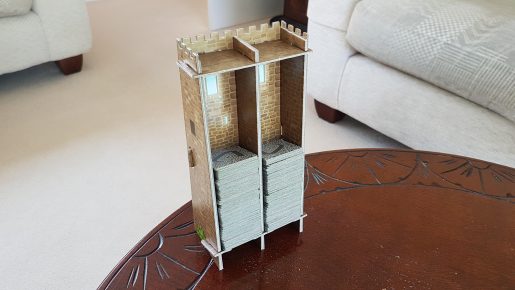Carcassonne: The Tower (Expansion 4) was originally released back in 2006 for the original edition of Carcassonne. Tower segments, a range of new tiles and a tile holder come into play via expansion 4, from designer Klaus-Jurgen Wrede. This latest print run has the same colourful cities of the newest, 2014 and onward, edition of Carcassonne. Meeples will be captured but is it worth the hassle of freeing them to play on? Let’s find out!
Carcassonne The Tower adds in 18 new tiles which, unsurprisingly, portray towers; alongside a range of the normal features. These are shuffled into the normal draw pile and are therefore randomly drawn from the pile during the game. Depending on the number of players, everyone will gain an amount of tower pieces at the beginning of the game, alongside their coloured meeples. For example, in a 2 player game both player receive 10 tower pieces.
When one of these tiles is drawn a player must place it like normal, extending the illustration. The player may then choose to either place a meeple onto a normal feature of the tile or take a tower action. Unlike meeples which must be placed onto the just placed tile, tower pieces can be added onto any tile with an unblocked tower feature. When you do this, you can capture a meeple from any feature on that tower tile or in up/down/left/right directions of distance equal to the towers height away from the tower tile (in a + like shape). To stop others being able to take your meeples you can during this tower action, instead of placing a tower piece, place a meeple onto the tower; effectively blocking it.
Not only does capturing remove an opponent’s meeple from a feature, potentially stopping them scoring it, it gives you their meeple. It cannot be used but if they at any point have a captured meeple of yours an automatic 1 for 1 trade is instantly initiated. The expansion would be overly punishing if this was the only way to get meeples back. Thankfully, you can always choose to pay 3 points to the capturer to get the meeple back. Note, if you do this during your turn it is even possible to place the meeple that turn. The tower pieces do not offer any end game points, neither does being on top of a tower, so this expansion revolves around this point denial mechanic of capturing rather than bonus points.
As with the majority of the Carcassonne expansions this is a small set of tiles but what sets The Tower apart is not the tower pieces or tiles that will be placed during the game. The aspect that make this expansion warrant the price tag is the tower itself. Included in the box is a prebuilt thick cardboard tower, designed to house/hold tiles during a game. Simply stack the tiles into the tower and draw from either of the two created stacks. It doesn’t change anything about drawing tiles: on the other hand, it makes the experience feel that bit more special. Especially the first-time players see the tower, it grabs their attention to what is otherwise a fairly flat game. Suddenly it isn’t just the large sprawling map of the end game that’ll attract players to the table.
The capture mechanism is rather cutthroat when playing with only two players, that can edge towards players feeling luck majorly comes into play if most of the tower tiles get drawn by a single player. Conversely, with a group of players there can be a meta problem as players start to choose between players, effectively kingmaking. This certainly makes these games more confrontational; just go into it thinking “All’s fair in love and Carcassonne” and you won’t be shocked at the outcome.
They way that The Tower expansion leaves incomplete cities, road and monasteries free of meeples, therefore unclaimed, I feel it would work naturally with The Flying Machines mini-expansion. This would see a great combination where a nearly complete feature could have a meeple captured from, for someone to then luckily land on them via a flying machine. Both have the take that vibe to them, where it’s more about screwing over an opponent that helping yourself. Therefore, it makes sense that if you like one of these expansions, you’ll like the other.
The tower pieces are uniquely shaped to that they stack on top of one another but always have a peak to them. They have the same solid wood feel to them that the standard meeples do. In addition to this, being uncoloured are not only easy to spot on the board but it is intuitively understood that no-one individually controls or owns the towers. The pieces give the game some height that the meeples of the base game and many other expansions fail to do, though it is rare for towers to go above a height of 3.
A range of new variations of city shapes, road turns and a single new cathedral are depicted on the tower tiles. These add that variety back into the game for those knowing exactly what tiles are available. Alas, it is a crying shame that the green grass of The Tower’s tiles simply doesn’t match the base game’s grass. It breaks the map illustration that grows in front of you, continuously catching players’ eyes. While it doesn’t break the mechanics, being purely visual, considering the number of expansions that fit seamlessly this is a strange, pretty unforgiveable, error to have.
Carcassonne The Tower is an interesting expansion as it uncovers what the game represents to individual people. Those that see the game as a light weight, family friendly, board game may be put off by the almost aggressive tower placement plays that can see a lot of points lost. For players that already fight over fields or attempt to contest each and every city, the concept of towers and capturing meeples will be more what you’re looking for. While I won’t include The Tower tiles in each game I play, due to the way the mechanic splits gamers, the physical tile holding tower is a welcome flair item to make every game played look and feel that bit more special.
[Editor’s Note: Carcassonne: The Tower was provided to us by Z-man Games for the purpose of the review.]

